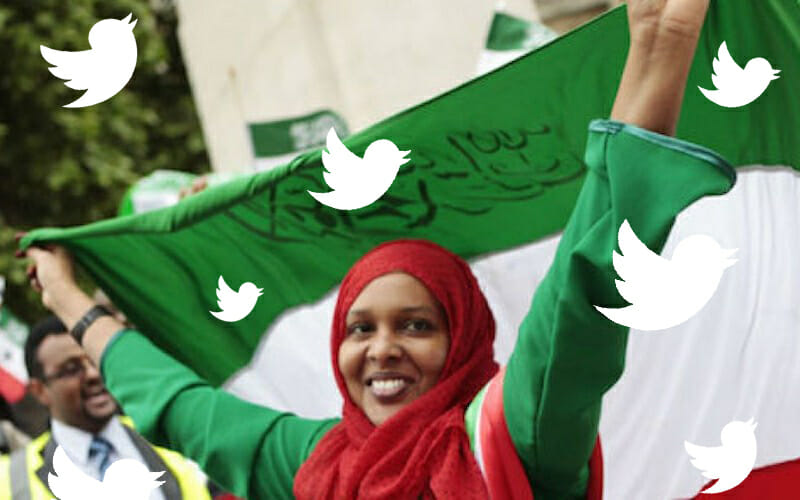
Social Media has Upended Politics in Somaliland
This presidential campaign may be the craziest, most divisive one in the history of the Republic of Somaliland. Don’t worry. I’m not going to get all political in this piece.
Everyone is biased, and social media shapes and broadcasts these biases in profound ways. Every time there’s a revolution in Africa, from Egypt to South Africa, Nigeria to Ethiopia, Zimbabwe to Somalia’s Farmaajo campaign slogan ‘Nabad iyo Nolol’ (peace and life), whatever it is — social media plays a part. In short, social media is changing Africa.
According to Mohamed Abdi Sheikh “Elig” Horn Cable TVs executive director, the news cycle has drastically changed in the past decade since the rise of the social network. As both Somaliland politicians and journalists often get much of their news from following key social media accounts where the news stories are also shared by readers/viewers, which has shifted the news cycle into a new paradigm.
Presidential candidates realized that using social media platforms can reach as many news outlets as a press conference in a much more efficient manner. By posting their views on Facebook and Twitter, politicians are able to gain immediate insight into how the public responds and can even interact candidly with their followers directly, a fact that draws a lot of younger people to use social media to research the issues. In this manner, Hon. Abdirahman Mohamed Abdullahi “Cirro” the presidential candidate for Somaliland’s main opposition party (Waddani) will go live on Facebook, just less than forty-eight hours before polling day.
Social media marketing campaigns can really stand out when done correctly, and an important piece of that puzzle is the hashtag. Hashtags allow accounts with large followings to create rallying points for their messages in a way that’s easy to track. Here are some of the leading hashtags during Somaliland Presidential Election Debate.
Inspire Groups #SomalilandDebates that made more than 3 million impressions on Twitter and #SomalilandVotes which is trending right now in the Horn of Africa. All this data shows that the campaign is definitely catering to social media.
UCID party leader, Faisal Ali Waraabe has the largest and most engaged social media following among the presidential candidates. Love him or hate him, you’ve heard of Faisal, and his social media exploits alone have earned him quite a bit of free attention from the mainstream media.
He may say offensive things, but you can be assured Faisal means what Faisal says. There’s a lesson here. The more unbalanced, bombastic, and extreme you are, the more free press you’ll get. People love a good fight. People love to feel angry. If you want to learn more about how people feel toward Faisal’s ideals, all you have to do is search his name on Twitter and Facebook. And that brings up an important point.
However, both Muse Bihi Abdi and Abdirahman Mohamed Abdullahi “Cirro” also have strong showings on other social networks like Facebook, Twitter and YouTube, where visual content trumps links and text. Although most political discussions online are taking place between regular users sharing news stories. It’s important to understand, however, these numbers don’t necessarily equate to registered voters who support a candidate, merely people whose attention they have.
The cyclical nature of news and marketing means that the same stories will simultaneously appear in various social and traditional media platforms. Many find their way to WhatsApp but many more originate from there. Unlike the other forms of social media, the WhatsApp groups drop all the way down to single family groupings or rise up to political party collectives, with all the other subdivisions in between (clan, town, city, religious, women, etc.). Here ideas are shared, grievances discussed and plans are formulated. Whether by design or accident, the Somaliland political parties utilized such groups and embedded their own operatives, activists and supporters to promote the parties’ manifestos and future strategies. Whilst some may decry the clannish nature of such groups (and that’s indeed an argument worth exploring), we nevertheless cannot ignore social media’s ability to engage the electorate and allow them to feel a tangible connection to the process that goes beyond registration and voting. Here the “influencers” are influenced and, in turn, influence party policy.
The journey to the 13th of November however started way before that date. Both the ruling party and the opposition parties understood early enough the need to involve the youth of Somaliland. Prior to the elections, the presidential and vice presidential candidates opened Twitter accounts and made their presence known on social media in which they engaged directly with young people.
Social media usage is on the rise, and social networks are becoming an important part of every political strategy. A new force for political change is emerging across Africa: popular protest. Widespread urban uprisings by youth, the unemployed, trade unions, activists, writers, artists, and religious groups are challenging injustice and inequality.
Lively discussions, posts and virtual town hall meetings were held almost on a regular basis on cyber space. People were able to air their opinions, and for once in the bistros of the country, young people became actively involved politically. Indeed, social media helped shape the opinion of a lot of youth in the elections and increased the political awareness and consciousness of the youth of Somaliland, be it by offering a platform for the candidates to interact directly with voters or offering a setting to hold virtual town hall meetings.
The presidential elections have come and gone, winners and losers now know their fate. But the elections have definitely raised the bar for civic participation via social media for future elections in Somaliland.
